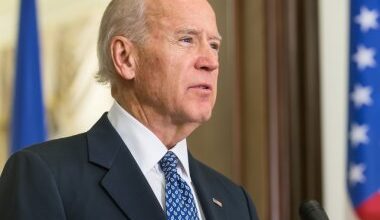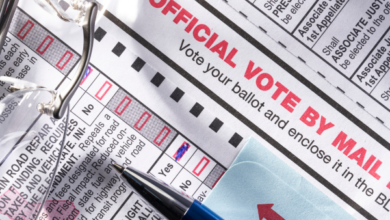Exploring US Political Divisions and Partisan Polarization – political polarization examples and its solutions to political polarization in America 2023
Exploring US Political Divisions and Partisan Polarization - political polarization examples and its solutions to political polarization in America 2023

In recent years, it seems like the United States has become increasingly divided along political lines. From heated social media debates to tense family gatherings, it’s hard to escape the feeling that we are a nation deeply polarized.
But what exactly is causing this political polarization and why is it such a problem? In this blog post, we’ll explore some of the key factors driving partisan divisions in America and discuss potential solutions for bridging these divides.
Whether you’re a seasoned politico or simply someone interested in understanding our current political landscape, read on to discover more about one of the most pressing issues facing our country today: political polarization.
What is political polarization and why is it a problem?
Political polarization refers to the increasing divide between political viewpoints in a society. In America, this has resulted in an extremely divided political climate where individuals seem unable to find common ground on important issues.
This is problematic because it hampers progress and prevents lawmakers from finding solutions that benefit everyone.
Political polarization can lead to gridlock within government as parties refuse to work together or compromise on key policy decisions. This means that important legislation may not be passed, leading to negative consequences for citizens who rely on government services.
Additionally, political polarization can lead to increased hostility between individuals with opposing views. It feeds into a “us vs them” mentality which results in more extreme language and behavior towards those with different beliefs.
Ultimately, political polarization threatens the very foundations of democracy by eroding trust in institutions and preventing meaningful dialogue across party lines.
Finding ways to reduce political polarization will be essential if we want our democracy to thrive and continue working for all Americans.

The causes of political polarization in America
There are several factors that contribute to political polarization in America. One of the main causes is the increasing influence of money in politics, which has led to a rise in special interests and lobbying groups.
Another factor is the role of media outlets, which tend to cater to specific audiences with their programming and reporting.
This has created an echo chamber effect where individuals only consume news that aligns with their pre-existing beliefs, leading to further division between different political ideologies.
Additionally, social media platforms have played a significant role in fueling political polarization by allowing users to curate content based on personal preferences and biases. This reinforces existing views while limiting exposure to alternative perspectives and ideas.
Gerrymandering – the practice of drawing voting districts for partisan advantage – has contributed heavily towards polarizing American politics as it can result in disproportionate representation and less competitive elections.

The effects of political polarization on American politics
The effects of political polarization on American politics have been significant in recent years. One major impact is the breakdown of bipartisanship and compromise, leading to gridlock in government.
As each party becomes more polarized, they become less willing to work with the other side. This has resulted in numerous government shutdowns and stalled legislation that could benefit Americans.
Another effect of political polarization is the rise of extreme voices within each party. Candidates who hold views further from the center are gaining popularity, which can lead to policies that do not represent a broad range of perspectives.
Additionally, political polarization has created an environment where voters are more likely to disregard information that does not align with their beliefs.
This makes it difficult for politicians or media outlets to sway public opinion or reach common ground.
Political polarization can also undermine democracy itself by eroding trust in institutions and processes such as voting rights and election integrity.
These effects show why finding solutions to reduce political polarization is crucial for American politics moving forward.

Solutions to political polarization in America
Promoting greater political diversity
Promoting greater political diversity in American politics can be achieved through two key reforms: redistricting and open primaries. Redistricting reform involves creating more competitive electoral districts that represent a broader range of political views, rather than districts that are gerrymandered to favor one political party.
Further, Open primaries allow voters to participate in the primary elections of any party, regardless of their own party affiliation, which helps to ensure that candidates who are more moderate and appeal to a wider range of voters have a better chance of winning.
However, By implementing these reforms, we can help to promote greater political diversity and encourage elected officials to represent a wider range of viewpoints.
Investing in civics education
Investing in civics education can help young people develop a deeper understanding of American government and its political processes. Civics education teaches the importance of compromise and civil discourse in a democracy, helping students to develop critical thinking and communication skills.
Further, Through civics education, young people can learn about different political perspectives and engage in respectful conversations with those who hold different views.
Moreover, This can help promote a culture of compromise and collaboration in politics, leading to more effective governance and the ability to tackle complex issues. Investing in civics education is therefore an important step towards building a more informed and engaged citizenry.
Engaging in respectful conversations
In American politics, there is often a lack of civility in conversations between people with different political views. However, engaging in respectful conversations can help bridge partisan divides and seek common ground.
By listening to others’ perspectives without judgment and responding in a respectful manner, individuals can create an environment for civil discourse. When we focus on finding common ground and areas of agreement, we can build trust and respect, even with those who hold differing viewpoints.
However, This can lead to more productive conversations and a greater willingness to compromise, helping to bridge the divide between political factions and create a more unified and effective society.
Prioritizing unity over division
In American politics, it is often the case that leaders prioritize scoring political points over solving problems. This has led to a divisive political environment, where issues are polarized and compromise is difficult to achieve.
Additionally, Leaders who prioritize unity over division are essential in solving problems, as they work to build consensus and bring people together towards a common goal. Such leaders focus on finding common ground and working towards solutions that benefit all Americans, rather than just their own political party.
By prioritizing unity, leaders can foster a more collaborative and effective political environment, where issues can be addressed in a constructive manner and progress can be made towards solving the country’s most pressing problems.
By implementing these solutions collectively as a society, we can begin bridging partisan divides and creating a more united America.
FAQs
Now that we have delved into the topic of political polarization in America, you may still have some lingering questions. Here are some common FAQs regarding this contentious issue.
What is the difference between political polarization and partisanship?
Partisanship refers to a person’s affiliation with a particular political party, while political polarization describes the increasing ideological distance between those on opposite ends of the partisan spectrum.
Is it possible to bridge the divide between Democrats and Republicans?
Yes, but it will require significant effort from both sides. It starts with acknowledging each other’s viewpoints and finding common ground. It also means holding our elected officials accountable for working towards compromise rather than just promoting their own agendas.
Can social media contribute to political polarization?
Yes, studies suggest that social media can create echo chambers where individuals only consume news and opinions that reinforce their existing beliefs. This leads to further entrenchment in one’s ideological bubble and less exposure to diverse perspectives.
What role do journalists play in addressing political polarization?
Journalists have an important responsibility to report objectively on issues without bias or sensationalism. They can also moderate discussions by providing platforms for respectful dialogue among people with differing views.
Understanding and addressing political polarization requires effort from all parties involved – citizens, politicians, journalists alike. By seeking out diverse perspectives and engaging in respectful dialogue, we can begin to move past these divisions towards a more united future.
Conclusion
Political polarization has become a major problem in the United States. It has led to increased tensions between political parties and prevented them from working together to solve important issues facing the country.
The causes of political polarization are complex, ranging from social media algorithms that promote echo chambers to the increasing influence of money in politics.
However, there are also solutions available that can help reduce partisan divisions and promote greater cooperation.
Some of these solutions include promoting more civil discourse, reducing the role of money in politics, and encouraging politicians to work across party lines.
Ultimately, it is up to all Americans – not just politicians – to take responsibility for reducing political polarization in America.
By engaging with people who have different viewpoints and being open-minded about new ideas, we can begin to bridge our differences and find common ground on important issues facing our nation today.


